 Wednesday
- August 2, 2006
Wednesday
- August 2, 2006
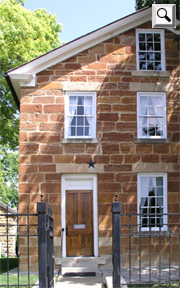 Today
was dedicated to Carthage and Nauvoo, the region from which Mormon pioneers
began their westward trek that would lead them to Utah. For Jenny and Vienna,
this would be a particularly meaningful day. For me, it was an opportunity to
learn more about the faith that influences them so deeply. We started at the
Carthage Jail where Mormon prophet Joseph Smith was shot to death by a vigilante
mob. As with virtually all important Mormon sites, we began our visit with a
spacious visitors' center that offered a couple of films. These movies are generally
designed to inform non-Mormons about the faith and offer a tiny amount of proselytizing.
Boxes of paper tissue are on hand for audience members for whom the films elicit
deep emotions. And even as a non-member (a lapsed one, actually) I must admit
that the depiction of Smith's slaying is pretty moving. Afterward we took a
Mormon missionary-led tour through the jail, climbing the stairs to the room
where the Mormon prophet died. We saw the bullet hole
that resulted in the death of Smith's older brother and found it easy to imagine
this moment that inspired the church's western exodus.
Today
was dedicated to Carthage and Nauvoo, the region from which Mormon pioneers
began their westward trek that would lead them to Utah. For Jenny and Vienna,
this would be a particularly meaningful day. For me, it was an opportunity to
learn more about the faith that influences them so deeply. We started at the
Carthage Jail where Mormon prophet Joseph Smith was shot to death by a vigilante
mob. As with virtually all important Mormon sites, we began our visit with a
spacious visitors' center that offered a couple of films. These movies are generally
designed to inform non-Mormons about the faith and offer a tiny amount of proselytizing.
Boxes of paper tissue are on hand for audience members for whom the films elicit
deep emotions. And even as a non-member (a lapsed one, actually) I must admit
that the depiction of Smith's slaying is pretty moving. Afterward we took a
Mormon missionary-led tour through the jail, climbing the stairs to the room
where the Mormon prophet died. We saw the bullet hole
that resulted in the death of Smith's older brother and found it easy to imagine
this moment that inspired the church's western exodus.
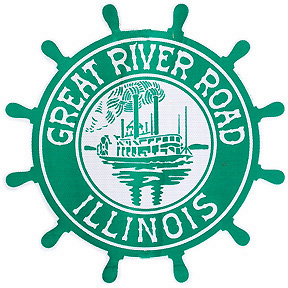 We
then joined the Great River Road north a few miles to the town of Nauvoo, a
town that also links with the Lincoln Heritage Trail,
serving as a reminder for us to start memorizing the Gettysburg Address as we
committed to do in Washington D.C. The highway roughly follows the Mississippi
River whose banks alight with fields of water lilies.
We stopped for a moment to look into the water. Jenny said that it "teems
with life," though I could only see a few dragonflies darting amid the
frog pads. The day promised the kind of muggy heat that would be found in swampland.
To think that Mormons built a city nearby! Sure enough we soon wound the road
toward their last stand. Nauvoo was to be a refuge from the armed mobs that
persecuted Mormons in Ohio and Missouri. There, they drained the marsh, platted
a town, and built a temple where they would perform ordinances sacred to their
faith.
We
then joined the Great River Road north a few miles to the town of Nauvoo, a
town that also links with the Lincoln Heritage Trail,
serving as a reminder for us to start memorizing the Gettysburg Address as we
committed to do in Washington D.C. The highway roughly follows the Mississippi
River whose banks alight with fields of water lilies.
We stopped for a moment to look into the water. Jenny said that it "teems
with life," though I could only see a few dragonflies darting amid the
frog pads. The day promised the kind of muggy heat that would be found in swampland.
To think that Mormons built a city nearby! Sure enough we soon wound the road
toward their last stand. Nauvoo was to be a refuge from the armed mobs that
persecuted Mormons in Ohio and Missouri. There, they drained the marsh, platted
a town, and built a temple where they would perform ordinances sacred to their
faith.
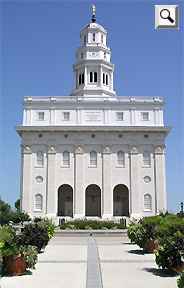 As we turned a corner, Jenny gasped upon seeing the temple for the first time.
Its tall and brilliantly white edifice stands on a
hill that commands the surrounding countryside. Mormons built this temple out
of confidence that they had finally found a safe haven from their persecutions.
But the violence that forced them here forced them to leave once more, allowing
their temple to be burnt to the ground by arsonists. Recently, however, the
LDS Church was able to rebuild the temple to nearly original specifications.
Around it, Nauvoo offers an impressive array of historical sites that allows
visitors to learn about Mormon heritage. The town also manages to balance the
interests of Mormon tourists along with folks who stayed behind and formed the
Reorganized Church, which is now a tiny sect called the Community of Christ.
As we turned a corner, Jenny gasped upon seeing the temple for the first time.
Its tall and brilliantly white edifice stands on a
hill that commands the surrounding countryside. Mormons built this temple out
of confidence that they had finally found a safe haven from their persecutions.
But the violence that forced them here forced them to leave once more, allowing
their temple to be burnt to the ground by arsonists. Recently, however, the
LDS Church was able to rebuild the temple to nearly original specifications.
Around it, Nauvoo offers an impressive array of historical sites that allows
visitors to learn about Mormon heritage. The town also manages to balance the
interests of Mormon tourists along with folks who stayed behind and formed the
Reorganized Church, which is now a tiny sect called the Community of Christ.
Throughout the afternoon, we visited almost a handful of the town's dozens of
historic sites, ducking in and out of the 100-degree heat.
Stops included memorials to Mormon women, a cultural center where Joseph Smith
was said to map out the journey to Utah, a bakery (that we visited primarily
for free ginger cookies) and the gravesites for Joseph, Hyrum, and Emma Smith.
We concluded the afternoon with the Trail of Hope, a pathway that leads from
the town center to the river's edge. Walking the trail, we followed the course
of Mormons who were forced to flee Nauvoo, leaving their magnificent temple
barely finished. Gordon B. Hinckley, the current church prophet, has recommended
that church members walk this path at least once in their lives to understand
the suffering and ultimate triumph of the Saints. For Jenny, that was all she
needed to hear. Even I was touched by the sad view this trail offers: one last
view of the temple on the hill that the pioneers knew they'd never see again.
 Our
night was dedicated to visiting the Nauvoo Pageant, an almost two-hour depiction
of Mormon pioneer life featuring the singing, dancing, and acting talents of
a vast cast of volunteers. By twilight, the field before the stage was filled
activities that included a dance band (square dances and waltzes, mostly), a
puppet show, and games like stick-pull, a favorite game of Joseph Smith. In
this contest, two opponents sit on the ground with their the balls of their
feet pushed against each other. Both hold onto a stick lengthwise and attempt
to pull each other over. Jenny was surprised when Vienna won their bout easily.
Vienna and I also had a chance to pull a cart like the ones used by Mormon pioneers
in a large circle through the woods, working up quite a sweat in the process.
Our
night was dedicated to visiting the Nauvoo Pageant, an almost two-hour depiction
of Mormon pioneer life featuring the singing, dancing, and acting talents of
a vast cast of volunteers. By twilight, the field before the stage was filled
activities that included a dance band (square dances and waltzes, mostly), a
puppet show, and games like stick-pull, a favorite game of Joseph Smith. In
this contest, two opponents sit on the ground with their the balls of their
feet pushed against each other. Both hold onto a stick lengthwise and attempt
to pull each other over. Jenny was surprised when Vienna won their bout easily.
Vienna and I also had a chance to pull a cart like the ones used by Mormon pioneers
in a large circle through the woods, working up quite a sweat in the process.
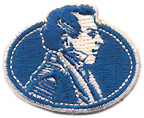 Prior
to the pageant, we encountered some of the animosity that continues to surround
the Mormon Church. Entering the grounds, I was handed what appeared to be a
flyer related to the show. A few steps later, an organizer handed me an "authorized"
flyer. He warned me that the other paper was "poison" and that I ought
to throw it out. Sure enough, the first paper was an anti-Mormon tract that
starts out innocuously before getting to its real purpose. Contrasting these
efforts, pageant organizers and cast-members walked about, striking up "conversations"
with folks. Wearing my travel uniform of flip-flops, camouflage shorts and t-shirt,
I drew three or four of these conversations. "Where are you from? Is your
family here? How have you enjoyed your visit to Nauvoo?" I'm sure they
were instructed not to proselytize, merely to inspire a spirit that could open
the door to more direct appeals down the road.
Prior
to the pageant, we encountered some of the animosity that continues to surround
the Mormon Church. Entering the grounds, I was handed what appeared to be a
flyer related to the show. A few steps later, an organizer handed me an "authorized"
flyer. He warned me that the other paper was "poison" and that I ought
to throw it out. Sure enough, the first paper was an anti-Mormon tract that
starts out innocuously before getting to its real purpose. Contrasting these
efforts, pageant organizers and cast-members walked about, striking up "conversations"
with folks. Wearing my travel uniform of flip-flops, camouflage shorts and t-shirt,
I drew three or four of these conversations. "Where are you from? Is your
family here? How have you enjoyed your visit to Nauvoo?" I'm sure they
were instructed not to proselytize, merely to inspire a spirit that could open
the door to more direct appeals down the road.
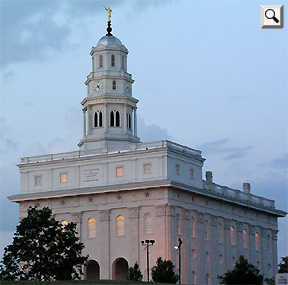 At last the sun began to set and the pageant began.
It's an impressive show that depicts the founding of the city, the building
of the temple, and the Mormon exodus away from their new home. Much of the story
was seen through the eyes of a Scottish immigrant who grudgingly followed his
wife to join the prophet despite his own misgivings about the church. He settles
into the community, helps to build the temple and - you guessed it - develops
his own testimony of the Mormon faith (later on, Jenny couldn't help but suggest
some parallels to that stubborn Scotsman and her husband). For a volunteer cast,
this performance was professionally done and often quite inspiring, particularly
when the "temple" they'd built seemed to melt away only to reveal
the real temple that had been rededicated in 2002, lit up and glowing against
the night. Following the end of the pageant, announcers reminded visitors that
they could receive free DVDs about the church and, I'm sure, follow-up visits
from Mormon missionaries if they desired. We returned to the car and made our
way through a hail of bugs along the highway back to our motel. By midnight,
rain and thunder blew against the windows. We knew the heat wave, for us at
least, was over.
At last the sun began to set and the pageant began.
It's an impressive show that depicts the founding of the city, the building
of the temple, and the Mormon exodus away from their new home. Much of the story
was seen through the eyes of a Scottish immigrant who grudgingly followed his
wife to join the prophet despite his own misgivings about the church. He settles
into the community, helps to build the temple and - you guessed it - develops
his own testimony of the Mormon faith (later on, Jenny couldn't help but suggest
some parallels to that stubborn Scotsman and her husband). For a volunteer cast,
this performance was professionally done and often quite inspiring, particularly
when the "temple" they'd built seemed to melt away only to reveal
the real temple that had been rededicated in 2002, lit up and glowing against
the night. Following the end of the pageant, announcers reminded visitors that
they could receive free DVDs about the church and, I'm sure, follow-up visits
from Mormon missionaries if they desired. We returned to the car and made our
way through a hail of bugs along the highway back to our motel. By midnight,
rain and thunder blew against the windows. We knew the heat wave, for us at
least, was over.
| GO FORWARD |